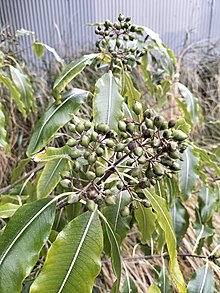Stathmopoda skelloni
| Stathmopoda skelloni | |
|---|---|

| |
| Scientific classification | |
| Domain: | Eukaryota |
| Kingdom: | Animalia |
| Phylum: | Arthropoda |
| Class: | Insecta |
| Order: | Lepidoptera |
| Family: | Stathmopodidae |
| Genus: | Stathmopoda |
| Species: | S. skelloni
|
| Binomial name | |
| Stathmopoda skelloni | |
| Synonyms[2] | |
| |
Stathmopoda skelloni, the yellow featherfoot, is a species of moth in the Stathmopodidae family.[3] It is endemic to New Zealand and can be found throughout the country. This species inhabits native forest, coastal dunes and shrubland as well as cultivated gardens and orchards. The larvae of this species feed on a variety of plant species including agricultural crops such as kiwifruit and persimmons. The adult moths are on the wing from September until March and are nocturnal but are attracted to light.
Taxonomy
[edit]This species was first described by Arthur Gardiner Butler in 1880 and named Boocara skelloni.[2][4] Butler named this species in honour of William Skellon who had sent various specimens he had collected in Blenheim to Butler.[4] In 1889 Edward Meyrick placed this species within the genus Stathmopoda.[5] In 1921 Meyrick synonymised Stathmopoda fusilis with Stathmopoda phlegyra, which in turn was synonymsied by J. S. Dugdale in 1988 with this species.[2] The female holotype specimen, collected in Blenheim, is held at the Natural History Museum, London.[2] The common name for this species is the yellow featherfoot.[6]
The name skelloni was previously incorrectly used for S. horticola, a similar looking species which can be distinguished by the more extensive markings on the forewing of that species.[7]
Description
[edit]
Meyrick described this species as follows:
♂♀︎. 12-15mm. Head, palpi, and antennae pale whitish-ochreous. Thorax whitish-ochreous. Abdomen pale whitish-ochreous, greyish-tinged. Legs pale whitish-ochreous, anterior pair infuscated, apex of posterior tibiae grey. Forewings elongate, very narrow broadest near base, long-pointed ; whitish-ochreous, sometimes yellowish-tinged ; markings grey, very variable, sometimes partially margined by an ochreous suffusion ; normally an elongate spot on inner margin at 1⁄3, a second beneath costa in middle, a third in disc at 2⁄3, a fourth before apex, and a slender subcostal line from second spot to costa near apex, but these tend to be variously connected and confused ; sometimes a streak along fold, or along anterior part of costa ; rarely a dark ochreous-fuscous suffusion towards base of inner margin : cilia light grey, sometimes ochreous-tinged. Hindwings and cilia light grey.[5]
Distribution
[edit]This species is endemic to New Zealand and can be found throughout New Zealand including in Taranaki, Wellington, Blenheim, Nelson, Christchurch, Dunedin, Lake Wakatipu and Invercargill.[1][5][7]
Habitat and hosts
[edit]
S. skelloni is found in a variety of habitats including native forest, coastal dunes, shrubland as well as cultivated gardens and orchards.[7] The larvae of this species feed on a variety of native and introduced plants including dried gorse flowers, seeds and flowers of flax species, raupō seeds as well as fruits of lemonwood.[7] Larvae have been reared from dead and dying bracts, flowers, leaves and buds of kiwifruit, old flowers and seeds of Calystegia tuguriorum, the seedpods of Phormium tenax and from flowers of species in the genus Senecio.[8][9]
Behaviour
[edit]Adults are on the wing from September until March.[7] They are a nocturnal species and are attracted to light.[7] This species is similar to other species in its family in that at rest it holds its hind legs outside of its wings.[7] In this posture only the feet of its hind legs touch the ground.[7]
Interaction with humans
[edit]This species is a known pest of agricultural crops produced in New Zealand such as kiwifruit and persimmons.[10][11] Although found to be less frequently observed than S. horticola, S. skelloni is still regarded as an agricultural pest as its larvae are more likely to cause fruit damage compared to other agricultural pest moth species.[12]
References
[edit]- ^ a b "Stathmopoda skelloni (Butler, 1880)". www.nzor.org.nz. Landcare Research New Zealand Ltd. Retrieved 3 February 2018.
- ^ a b c d Dugdale, J. S. (1988). "Lepidoptera - annotated catalogue, and keys to family-group taxa" (PDF). Fauna of New Zealand. 14: 108. Retrieved 3 February 2018.
- ^ Gordon, Dennis P., ed. (2010). New Zealand inventory of biodiversity. Volume two. Kingdom animalia : chaetognatha, ecdysozoa, ichnofossils. Vol. 2. Christchurch, N.Z.: Canterbury University Press. p. 4463. ISBN 9781877257933. OCLC 973607714.
- ^ a b Butler, A. G. (1880). "On a collection of Lepidoptera Heterocera from Marlborough Province, New Zealand". Cistula Entomologica. 2: 541–562 – via Biodiversity Heritage Library.
- ^ a b c Meyrick, Edward (May 1889). "Descriptions of New Zealand Micro-Lepidoptera". Transactions and Proceedings of the New Zealand Institute. 21: 154–188 – via Biodiversity Heritage Library.
- ^ "Yellow Featherfoot (Stathmopoda skelloni)". iNaturalist.org. Retrieved 2019-02-04.
- ^ a b c d e f g h Hoare, Robert J. B. (2014). A photographic guide to moths & butterflies of New Zealand. Ball, Olivier. Auckland: New Holland Publishers (NZ) Ltd. p. 36. ISBN 9781869663995. OCLC 891672034.
- ^ "Stathmopoda skelloni (Butler, 1880)". plant-synz.landcareresearch.co.nz. Retrieved 2022-05-31.
- ^ Brian H. Patrick (1994), Coastal butterflies and moths of Wellington and South Wairarapa. (PDF), Wikidata Q110426707, archived from the original (PDF) on 13 December 2021
- ^ Susan J. Muggleston (April 1989). "Rearing and the effects of photoperiod and temperature on diapause in Stathmopoda aposema (Lepidoptera: Oecophoridae: Stathmopodinae)". New Zealand Journal of Zoology. 16 (2): 199–204. doi:10.1080/03014223.1989.10422569. ISSN 0301-4223. Wikidata Q112181427.
- ^ "Importation of Fresh Persimmons From New Zealand Into the United States". unblock.federalregister.gov. Retrieved 2022-05-31.
- ^ D. Steven (April 1992). "PEST LEPIDOPTERA OF KIWIFRUIT IN NEW ZEALAND". Acta Horticulturae (297): 531–536. doi:10.17660/ACTAHORTIC.1992.297.69. ISSN 0567-7572. Wikidata Q112181580.
